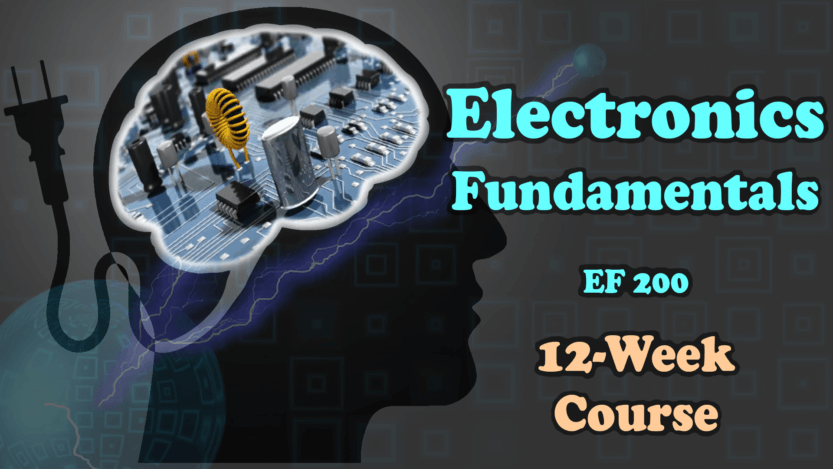
"Electronics Fundamentals Course"
is Essential Electronics Course for all Engineering Students!

Kick start your Electronics abilities and develop essential skills for solving non-linear electrical circuits!
Learn the fundamentals of Electronics Engineering. Whether you are Electrical Engineering or any other engineering student, this course will teach you the necessary fundamentals!
Live 12-Week Course (offered every quarter)
The delivery of the course material has been meticulously designed with early engineering students in mind. All the live sessions are recorded in High Definition and recordings are provided to students for later use. Lecture slides and tutorial problems with solutions are provided as additional resources in PDF format.
There is 88% Chance You Will Not Finish an Online Course on Your Own!
A stunning online course statistics shows that only 50% of students who purchase an online course bother to access it, but never watch a single lesson or study any of it!
Worse yet, 23% never even access the course they purchased, let alone study it or learn anything from it!
Only 12% of the students finish studying an online course on their own…
Find Your Motivation and Increase Engagement through Live Course Attendance
Live courses work, sort of, like your accountability buddy! Interaction with the teacher develops more productive atmosphere and significantly increases the success of your study. Your participation will be more regular and timely help provided will skyrocket your learning experience.
About the Course – Essential Course Facts
| Course Title: | Electronics Fundamentals Course |
| Course Subtitle: | Essential Electronics Course for all Engineering Students! |
| Course Type: | Live Weekly Delivery by the Teacher |
| Course Offered: | Starting every January, April, July and October |
| Course Duration: | 12 Weeks: 2h Lectures + 1h Problem Solving Tutorial |
| Instructor: | Mr. Sasha Jakovljevic (Electrical Engineer Sasha) |
Work with an Experienced Teacher
Sasha has been teaching University level courses since 2015. He has discovered the perfect balance between lecturing difficult engineering topics and an approach to make even the most difficult concepts simplified and easy for his students to learn. All this while keeping the lectures engaging and interesting, providing all the necessary “tricks of the trade”, important emphasis, cheat-sheets, summaries….
What Does the Course Cover? – Course Curricula Week-by-Week
12 Weeks • 24h of Lectures • 12h of Problem Solving Tutorials!
- Diode operation: direct & inverse polarization and breakdown region
- Non-linear diode characteristic (reading data sheets & catalogs; ratings)
- Load line analysis (graphical approach to solving a diode circuit)
- Numerical approach using iterative process with assumptions
- Diode types: Signal, Zener, Light Emitting Diodes (LEDs)
- Application of diodes – rectifiers, regulators, circuit protection
- 1st transistor type: Bipolar Junction Transistor (BJT)
- Physical design, layers, terminals, semiconductor types
- Operation of BJT: current relationships, regions of operation
- 2nd transistor type: Field Effect Transistor (FET)
- Physical design, layers, terminals, semiconductor types
- Operation of FET: voltage control, regions of operation
- Non-linear transistor characteristics (reading data sheets & catalogs; ratings)
- Transistors in linear mode & transistors as switches
- Ideal operational amplifiers (Op-Amps)
- Input currents, voltage & input resistance; amplification
- Voltage & current rules (solving Op-Amp circuits)
- Inverting & non-inverting operational amplifier circuits
- Voltage followers & voltage summation circuits
- Operational amplifier circuits with batteries & diodes
- Operational amplifier circuits with capacitors & inductors
- Silicon Controlled Rectifier (SCR)
- Physical design, layers, terminals, semiconductor types
- Thyristor compared to a diode – similarities & differences
- Thyristor compared to a transistor – similarities & differences
- Non-linear thyristor characteristic (reading data sheets & catalogs; ratings)
- AC & DC circuits with thyristors – behavior & analysis
- Application of thyristors – phase control circuit
- Insulated Gate Bipolar Transistor (IGBT), Triac & Diac
- Basic principles – sensing temperature & light
- Sensing position – various ways to indirectly detect position
- Hall effect sensors – using magnetism for sensing
- Design of sensors & role of sensors in control circuits
- Sensing motion – Passive Infra-Red (PIR) sensors
- Sensing vibration, tension, force & pressure
- Passive vs active sensors & analog vs digital sensors
- Application of sensors in various engineering disciplines
- Rectification of A/C signals & obtaining DC signals
- Half-wave rectifiers with a single diode
- Full-wave rectifier with a single diode & mid-tap transformer
- Full-wave rectifier with four diodes (diode bridge)
- Single phase rectification with thyristors
- Half- and fully-controlled rectifier bridge with thyristors
- 3-Phase rectification with thyristors
- Voltage regulation & stabilization (perfect smoothing)
- Application of Zener diodes for voltage regulation
- Voltage regulator Integrated Circuits (ICs)
- The Buck & Boost voltage (switching) regulators
- Duty cycle & the Flyback regulator
- Constant & variable voltage power supplies
- Efficiency, temperature raise & ripple ratings
- Amplification or gain of an amplifier circuit
- Input & output resistance of an amplifier
- Ideal amplifier circuit & efficiency of amplifiers
- Amplifier circuit with common emitter & characteristics
- Types of amplifiers & quality of amplification
- Distortion: magnitude, phase, frequency & crossover
- Passive attenuators (opposite from amplifiers)
- Basic LC oscillator (feedback circuit)
- Hartley oscillator (including Op-Amp version)
- Colpitts oscillator (including Op-Amp version)
- RC oscillator with BJT or operational amplifier
- The Wien Bridge & Twin-T oscillators
- Quartz crystals as oscillation stabilizers
- Operational amplifier multivibrator
- Variety of signal waveform types & shapes
- Characteristics of periodic (cyclical) waveforms
- Function generator IC (waveform generator IC)
- Monostable, bistable & astable multivibrator circuits
- Schmitt & clock waveform generators
- NE555 timer oscillator integrated circuit
- Boolean algebra & logic functions
- Laws of Boolean algebra & truth tables
- DeMorgan’s theorems & equivalent gates
- Switching theory & common circuit applications
- Sum of product & product of sum expression gates
- Combinatorial logic circuits – multiplexers & encoders
- Integrated Circuits (ICs): TTL vs CMOS technology
- Digital logic states, voltage levels & noise effects
- AND, OR, NOT, NOR & NAND logic gates
- Digital buffers & sequential logic circuits
- Flip flops, multivibrators, counters & shift registers
- Universal logic gates
Title
Lorem ipsum dolor sit amet, consectetur adipiscing elit. Ut elit tellus, luctus nec ullamcorper mattis, pulvinar dapibus leo.
Title
Lorem ipsum dolor sit amet, consectetur adipiscing elit. Ut elit tellus, luctus nec ullamcorper mattis, pulvinar dapibus leo.
Detailed Breakdown of Topics Covered Each Week
1. Diodes
- Diode operation: direct & inverse polarization and breakdown region
- Non-linear diode characteristic (reading data sheets & catalogs; ratings)
- Load line analysis (graphical approach to solving a diode circuit)
- Numerical approach using iterative process with assumptions
- Diode types: Signal, Zener, Light Emitting Diodes (LEDs)
- Application of diodes – rectifiers, regulators, circuit protection
2. Transistors
- 1st transistor type: Bipolar Junction Transistor (BJT)
- Physical design, layers, terminals, semiconductor types
- Operation of BJT: current relationships, regions of operation
- 2nd transistor type: Field Effect Transistor (FET)
- Physical design, layers, terminals, semiconductor types
- Operation of FET: voltage control, regions of operation
- Non-linear transistor characteristics (reading data sheets & catalogs; ratings)
- Transistors in linear mode & transistors as switches
3. Operational Amplifiers
- Ideal operational amplifiers (Op-Amps)
- Input currents, voltage & input resistance; amplification
- Voltage & current rules (solving Op-Amp circuits)
- Inverting & non-inverting operational amplifier circuits
- Voltage followers & voltage summation circuits
- Operational amplifier circuits with batteries & diodes
- Operational amplifier circuits with capacitors & inductors
4. Thyristors (Power Electronics)
- Silicon Controlled Rectifier (SCR)
- Physical design, layers, terminals, semiconductor types
- Thyristor compared to a diode – similarities & differences
- Thyristor compared to a transistor – similarities & differences
- Non-linear thyristor characteristic (reading data sheets & catalogs; ratings)
- AC & DC circuits with thyristors – behavior & analysis
- Application of thyristors – phase control circuit
- Insulated Gate Bipolar Transistor (IGBT), Triac & Diac
5. Electronic Sensors
- Basic principles – sensing temperature & light
- Sensing position – various ways to indirectly detect position
- Hall effect sensors – using magnetism for sensing
- Design of sensors & role of sensors in control circuits
- Sensing motion – Passive Infra-Red (PIR) sensors
- Sensing vibration, tension, force & pressure
- Passive vs active sensors & analog vs digital sensors
- Application of sensors in various engineering disciplines
6. Rectifiers
- Rectification of A/C signals & obtaining DC signals
- Half-wave rectifiers with a single diode
- Full-wave rectifier with a single diode & mid-tap transformer
- Full-wave rectifier with four diodes (diode bridge)
- Single phase rectification with thyristors
- Half- and fully-controlled rectifier bridge with thyristors
- 3-Phase rectification with thyristors
7. Voltage Regulators
- Voltage regulation & stabilization (perfect smoothing)
- Application of Zener diodes for voltage regulation
- Voltage regulator Integrated Circuits (ICs)
- The Buck & Boost voltage (switching) regulators
- Duty cycle & the Flyback regulator
- Constant & variable voltage power supplies
- Efficiency, temperature raise & ripple ratings
8. Amplifiers
- Amplification or gain of an amplifier circuit
- Input & output resistance of an amplifier
- Ideal amplifier circuit & efficiency of amplifiers
- Amplifier circuit with common emitter & characteristics
- Types of amplifiers & quality of amplification
- Distortion: magnitude, phase, frequency & crossover
- Passive attenuators (opposite from amplifiers)
9. Oscillators
- Basic LC oscillator (feedback circuit)
- Hartley oscillator (including Op-Amp version)
- Colpitts oscillator (including Op-Amp version)
- RC oscillator with BJT or operational amplifier
- The Wien Bridge & Twin-T oscillators
- Quartz crystals as oscillation stabilizers
- Operational amplifier multivibrator
10. Waveform Generators
- Variety of signal waveform types & shapes
- Characteristics of periodic (cyclical) waveforms
- Function generator IC (waveform generator IC)
- Monostable, bistable & astable multivibrator circuits
- Schmitt & clock waveform generators
- NE555 timer oscillator integrated circuit
11. Digital Electronics
- Boolean algebra & logic functions
- Laws of Boolean algebra & truth tables
- DeMorgan’s theorems & equivalent gates
- Switching theory & common circuit applications
- Sum of product & product of sum expression gates
- Combinatorial logic circuits – multiplexers & encoders
12. Digital Logic Gates
- Integrated Circuits (ICs): TTL vs CMOS technology
- Digital logic states, voltage levels & noise effects
- AND, OR, NOT, NOR & NAND logic gates
- Digital buffers & sequential logic circuits
- Flip flops, multivibrators, counters & shift registers
- Universal logic gates
* Due to every class being unique and due to interactive nature of live classes, the Lecturer reserves the right to adjust and modify the actual content delivery, which may result in exclusion of some of the above-mentioned topics and/or inclusion of some other topics not mentioned above, as well as shuffling some topics around during the 12-weeks delivery period
My Student Testimonials

100% No-Risk Money Back Guarantee!
You are fully protected by my 100% No-Risk Guarantee. If you are not satisfied with the course over the first 30 days, then I will unconditionally give you a full refund which is 100% of your money back.
No questions asked!
What you will learn in this course:
- A
- B
- C
- D
- E
- F
What you'll learn
Bulletpoints
More
- More

100% No-Risk Money Back Guarantee!
You are fully protected by my 100% No-Risk Guarantee. If you are not satisfied with the course over the next 30 days, then I will unconditionally give you a full refund which is 100% of your money back.
No questions asked!
